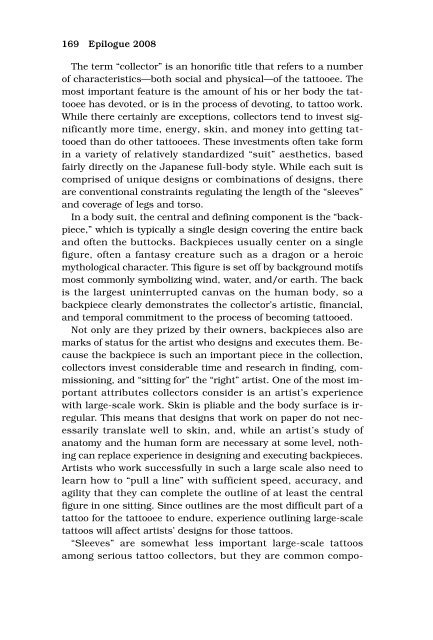Customizing the Body (PDF file) - Print My Tattoo
Customizing the Body (PDF file) - Print My Tattoo
Customizing the Body (PDF file) - Print My Tattoo
Create successful ePaper yourself
Turn your PDF publications into a flip-book with our unique Google optimized e-Paper software.
169 Epilogue 2008<br />
The term “collector” is an honorific title that refers to a number<br />
of characteristics—both social and physical—of <strong>the</strong> tattooee. The<br />
most important feature is <strong>the</strong> amount of his or her body <strong>the</strong> tattooee<br />
has devoted, or is in <strong>the</strong> process of devoting, to tattoo work.<br />
While <strong>the</strong>re certainly are exceptions, collectors tend to invest significantly<br />
more time, energy, skin, and money into getting tattooed<br />
than do o<strong>the</strong>r tattooees. These investments often take form<br />
in a variety of relatively standardized “suit” aes<strong>the</strong>tics, based<br />
fairly directly on <strong>the</strong> Japanese full-body style. While each suit is<br />
comprised of unique designs or combinations of designs, <strong>the</strong>re<br />
are conventional constraints regulating <strong>the</strong> length of <strong>the</strong> “sleeves”<br />
and coverage of legs and torso.<br />
In a body suit, <strong>the</strong> central and defining component is <strong>the</strong> “backpiece,”<br />
which is typically a single design covering <strong>the</strong> entire back<br />
and often <strong>the</strong> buttocks. Backpieces usually center on a single<br />
figure, often a fantasy creature such as a dragon or a heroic<br />
mythological character. This figure is set off by background motifs<br />
most commonly symbolizing wind, water, and/or earth. The back<br />
is <strong>the</strong> largest uninterrupted canvas on <strong>the</strong> human body, so a<br />
backpiece clearly demonstrates <strong>the</strong> collector’s artistic, financial,<br />
and temporal commitment to <strong>the</strong> process of becoming tattooed.<br />
Not only are <strong>the</strong>y prized by <strong>the</strong>ir owners, backpieces also are<br />
marks of status for <strong>the</strong> artist who designs and executes <strong>the</strong>m. Because<br />
<strong>the</strong> backpiece is such an important piece in <strong>the</strong> collection,<br />
collectors invest considerable time and research in finding, commissioning,<br />
and “sitting for” <strong>the</strong> “right” artist. One of <strong>the</strong> most important<br />
attributes collectors consider is an artist’s experience<br />
with large-scale work. Skin is pliable and <strong>the</strong> body surface is irregular.<br />
This means that designs that work on paper do not necessarily<br />
translate well to skin, and, while an artist’s study of<br />
anatomy and <strong>the</strong> human form are necessary at some level, nothing<br />
can replace experience in designing and executing backpieces.<br />
Artists who work successfully in such a large scale also need to<br />
learn how to “pull a line” with sufficient speed, accuracy, and<br />
agility that <strong>the</strong>y can complete <strong>the</strong> outline of at least <strong>the</strong> central<br />
figure in one sitting. Since outlines are <strong>the</strong> most difficult part of a<br />
tattoo for <strong>the</strong> tattooee to endure, experience outlining large-scale<br />
tattoos will affect artists’ designs for those tattoos.<br />
“Sleeves” are somewhat less important large-scale tattoos<br />
among serious tattoo collectors, but <strong>the</strong>y are common compo-



